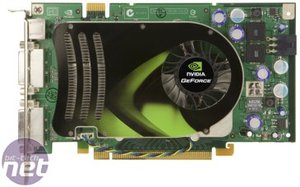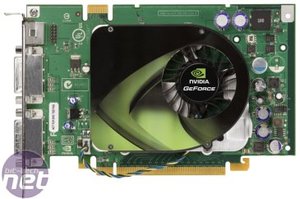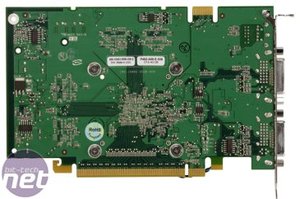With the GeForce 8-series architecture, Nvidia moved away from traditional clock speeds and there are now three notable clock speeds on each member of the GeForce 8 family. This is no different with the GeForce 8600-series and GeForce 8500-series, which all have the same ‘core’, stream processor and memory clock speeds.
The card’s core speed is set at 675MHz – this clock frequency represents the speed at which the set up and pixel output engines run at (the front and back end of the DirectX 10 pipeline). The texture address and texture filtering units also run at the same frequency, too. The stream processor clock, which represents the speed of the unified shader pipelines, runs at 1450MHz by default and finally, the four high-speed GDDR3 memory chips are clocked to 1000MHz (2000MHz effective).
As a result of these relatively high clock speeds, the GeForce 8600 GTS consumes a maximum of 71W according to Nvidia. The PCI-Express 1.1a specification stipulates that a maximum of 75W can be drawn through the PCI-Express x16 interconnect so, while it would have been possible for Nvidia not to include a power connector on the card, it would have meant there would be very little overclocking headroom. As a result, it’s no surprise to see the 6-pin PCI-Express connector on the card.
Both of the DVI connectors are dual-link capable and HDCP compliancy is compulsory on GeForce 8600 GTS. This is also the first video card to support HDCP over a dual-link DVI connection, too. The current GeForce 8800-series hardware and anything from either GeForce 7-series or Radeon X1000-series is only capable of HDCP over a single link DVI connection, meaning that you’re just greeted with a blank screen if you try playing protected content on a 30” monitor.
There is also a 7-pin analogue video out port which supports S-Video directly, and Component and Composite outputs via an external dongle. And finally, GeForce 8600 GTS has full support for HDMI, but it is up to the partners to implement it. There’s no word on how sound will be transferred across the HDMI connection though – we’re assuming that board partners will have to provide their own onboard HDCP compliant audio chip.
Nvidia states that GeForce 8600 GT consumes a maximum of 43W at its default clock speeds, and there should be plenty of room for overclocking without the need for a 6-pin PCI-Express power connector on the board.
Like the GeForce 8600 GTS, both of the DVI connectors on the GeForce 8600 GT are dual-link capable, but HDCP compliancy on is optional and up to the board partners to implement on their GeForce 8600 GT designs. If HDCP is implemented by board partners, there is no chance of it only being supported over a single link DVI connection.
When we asked Nvidia about this, we were told that it will definitely be supported over dual-link, as it is there by design – it doesn’t cost anymore for add-in partners to implement dual-link capable HDCP support. This is because the one key can be sent across the two separate links on the dual-link DVI connection. The dual-link monitor has two separate keys – one for each link – that will work together with G84’s single key. Finally, HDMI is also an optional extra too and its presence will be down to the AIBs.
GeForce 8600 GTS
GeForce 8600 GTS is the flagship model in Nvidia’s mainstream lineup, with prices ranging from $199 to $229 USD – this is about the same price point that the GeForce 7600 GT launched at, for reference purposes.The card’s core speed is set at 675MHz – this clock frequency represents the speed at which the set up and pixel output engines run at (the front and back end of the DirectX 10 pipeline). The texture address and texture filtering units also run at the same frequency, too. The stream processor clock, which represents the speed of the unified shader pipelines, runs at 1450MHz by default and finally, the four high-speed GDDR3 memory chips are clocked to 1000MHz (2000MHz effective).
As a result of these relatively high clock speeds, the GeForce 8600 GTS consumes a maximum of 71W according to Nvidia. The PCI-Express 1.1a specification stipulates that a maximum of 75W can be drawn through the PCI-Express x16 interconnect so, while it would have been possible for Nvidia not to include a power connector on the card, it would have meant there would be very little overclocking headroom. As a result, it’s no surprise to see the 6-pin PCI-Express connector on the card.
Both of the DVI connectors are dual-link capable and HDCP compliancy is compulsory on GeForce 8600 GTS. This is also the first video card to support HDCP over a dual-link DVI connection, too. The current GeForce 8800-series hardware and anything from either GeForce 7-series or Radeon X1000-series is only capable of HDCP over a single link DVI connection, meaning that you’re just greeted with a blank screen if you try playing protected content on a 30” monitor.
There is also a 7-pin analogue video out port which supports S-Video directly, and Component and Composite outputs via an external dongle. And finally, GeForce 8600 GTS has full support for HDMI, but it is up to the partners to implement it. There’s no word on how sound will be transferred across the HDMI connection though – we’re assuming that board partners will have to provide their own onboard HDCP compliant audio chip.
GeForce 8600 GT
GeForce 8600 GT is set to come in at $149 to $159 USD – to give you an idea of what this card will be replacing, it has a similar launch price to the GeForce 7600 GS. The reference speed for the 8600 GT’s core is 540MHz, while the stream processors are clocked at 1180MHz. Although the GeForce 8600 GT still uses GDDR3 memory, the clock frequency has been reduced from the 1000MHz default on GeForce 8600 GTS to 700MHz (1400MHz effective).Nvidia states that GeForce 8600 GT consumes a maximum of 43W at its default clock speeds, and there should be plenty of room for overclocking without the need for a 6-pin PCI-Express power connector on the board.
Like the GeForce 8600 GTS, both of the DVI connectors on the GeForce 8600 GT are dual-link capable, but HDCP compliancy on is optional and up to the board partners to implement on their GeForce 8600 GT designs. If HDCP is implemented by board partners, there is no chance of it only being supported over a single link DVI connection.
When we asked Nvidia about this, we were told that it will definitely be supported over dual-link, as it is there by design – it doesn’t cost anymore for add-in partners to implement dual-link capable HDCP support. This is because the one key can be sent across the two separate links on the dual-link DVI connection. The dual-link monitor has two separate keys – one for each link – that will work together with G84’s single key. Finally, HDMI is also an optional extra too and its presence will be down to the AIBs.

MSI MPG Velox 100R Chassis Review
October 14 2021 | 15:04













Want to comment? Please log in.